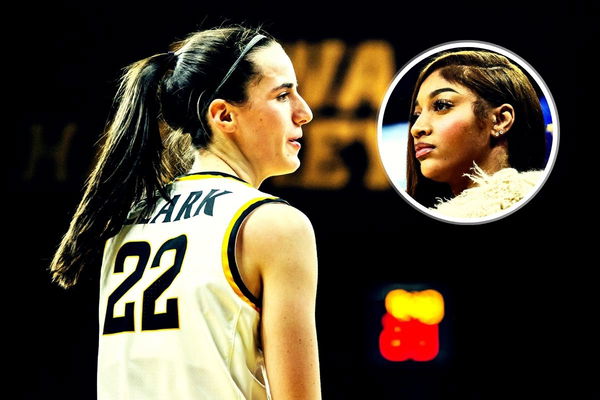

It seems like whenever Cathy Engelbert tries to defend, praise, or explain things, her responses always fall short. Remember her Johnson-Bird comparison? Yeah, that attempt at salvation landed her in even hotter waters. She admitted that the league was banking on Clark-Reese’s rivalry, and fans sounded off on one thing amongst many others: Why are the vaults still closed, then? Fast forward to now, and the hopes have paid dividends. She is now admitting that yes, the marketability and the viewership are increasing at a steady pace. However, she was a bit more careful with her words this time.
During Cathy Engelbert’s recent appearance on The David Rubenstein Show, she brought up three points, saying, “When I came into the league, people watched sports for three basic reasons — rivalries, games of consequence and household names. We didn’t have a lot of household names, even though we had amazing players back then — and still do beyond Caitlin and Angel.”
And there’s no denying that, honestly. In 2024, Clark’s Iowa victory over LSU shattered records, drawing 12.3 million viewers and peaking at 16 million. Meanwhile, Reese and Clark’s rivalry not only captivated fans but translated into a record-breaking 340,715 home attendance for the Indiana Fever, marking a 318.8% growth from the previous season. Drawing from that, Engelbert added, “We brought tens of millions of new people into our sport last year because this rivalry came out of college”. But, as the league breaks records and draws in millions of new fans, the questions remain.
ADVERTISEMENT
Article continues below this ad
The battle for gender pay equity is still unfolding, and it is far from over. No big updates are there as of now, and perhaps, that is why players like Bueckers are signing with leagues like Unrivaled even before signing the pro contract. Because by framing the duo as the face of the WNBA’s growth, Engelbert inadvertently highlighted a persistent issue: the league’s reliance on star players who are underpaid relative to their impact. This, hence, reminds us of what Napheesa Collier said at the second annual Changemakers Summit in a candid conversation with CNBC’s Julia Boorstin:
“Yeah so for the first thing is to kind of backtrack why we started this is women’s sports is exploding. I’m sure you guys have seen just rapidly growing and it feels like everyone is benefiting from that except for the women in the sports. And so that’s why we wanted to so why we’re so proud to offer the highest average salary why equity having all the players have equity in the league was really important to us. So that is how like treating women’s athletes how they should be treated.”
In an industry where women’s sports have been steadily climbing, Collier’s words carry weight. The contrast to the NBA is undeniable. In 2024, the highest-paid player in the WNBA, Jackie Young, earned a base salary of $252,420. Meanwhile, Branden Carlson, a rookie with the Oklahoma City Thunder, brought home $990,895—a staggering sum that’s nearly four times what Young received. This glaring pay disparity is a testament to the broader gender pay gap that continues to haunt professional sports.
And it’s not just about a single salary figure—it’s about the bigger picture. According to Real GM Wiretap, despite the WNBA’s substantial growth, with projections placing the league’s total revenue between $180 million and $200 million in 2023, players’ share of this revenue has shrunk. In fiscal 2019, players earned 11.1% of the league’s revenue, but by fiscal 2022, that figure had dropped to just 9.3%. A rapid increase in business hasn’t been met with a proportional increase in player compensation, leaving a stark imbalance. So, Collier’s words hit harder than ever. “It feels like everyone is benefitting from that, except for the women in the sports,” she further said.
While Napheesa Collier, who made it to CNBC’s Changemaker list, is driving transformative change off the court, she’s equally determined to ensure her on-court prowess leaves no room for skepticism about her advocacy.
What’s your perspective on:
Is the WNBA's growth overshadowed by its failure to fairly compensate its star players?
Have an interesting take?
Collier’s Quest for Redemption: Bouncing Back from 2024’s Finals and Unrivaled Setback
After falling short in both the 2024 WNBA Finals and the inaugural Unrivaled season, Napheesa Collier is back and more determined than ever to lead the Minnesota Lynx to glory. While Collier’s 2024 campaign saw her fall to the New York Liberty in the WNBA Finals, her Unrivaled experience wasn’t any kinder.

via Imago
Oct 13, 2024; Brooklyn, New York, USA; New York Liberty forward Breanna Stewart (30) looks to drive past Minnesota Lynx forward Napheesa Collier (24) in the fourth quarter during game two of the 2024 WNBA Finals at Barclays Center. Mandatory Credit: Wendell Cruz-Imagn Images
Despite being one of the league’s top players, Collier’s team came up short in the finals, denying her the chance to claim the 3-on-3 league’s crown. This dual heartbreak has only fueled her hunger for redemption.
ADVERTISEMENT
Article continues below this ad
And let us not forget the multitude of chances her own league gave her to improve. Remember how, despite being W’s one of the best two-way players, there were doubts about her averaging more points, calls for even further improvements? Well, she is all ready to push beyond the numbers as the Unrivaled offered her no chances to hide on either end of the floor. Also, after the controversial officiating calls last year, it is clear that Collier and Co. will be playing with a chip on their shoulder.
Meanwhile, the Lynx are gearing up for a fresh shot at the WNBA title in 2025, making a key move by re-signing veteran forward Jessica Shepard. Shepard, who’s bounced back from injuries to become a steady contributor, could be the missing piece to complete the puzzle. In 2022, Shepard averaged 8.1 points and 7.4 rebounds per game, and her experience will add crucial depth to a Lynx team hungry for the championship they narrowly missed last season.
ADVERTISEMENT
Article continues below this ad
With Collier leading the charge, the Lynx are ready to rise again. The 2025 season promises fierce competition, with the Liberty and Aces still standing in their way, but the Lynx are determined to break through.
ADVERTISEMENT
ADVERTISEMENT
ADVERTISEMENT
ADVERTISEMENT


Is the WNBA's growth overshadowed by its failure to fairly compensate its star players?